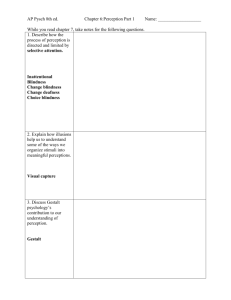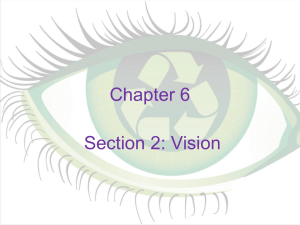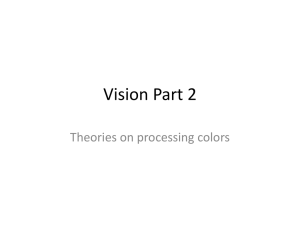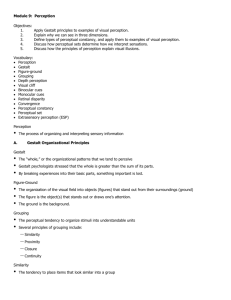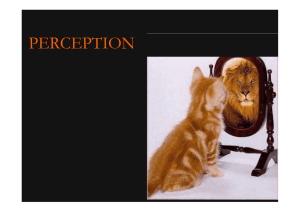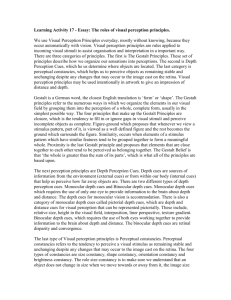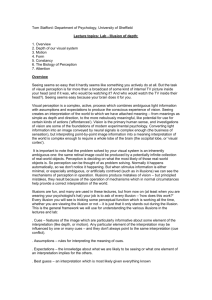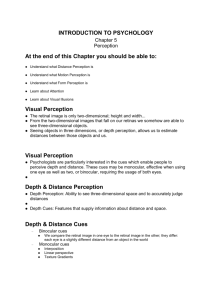File
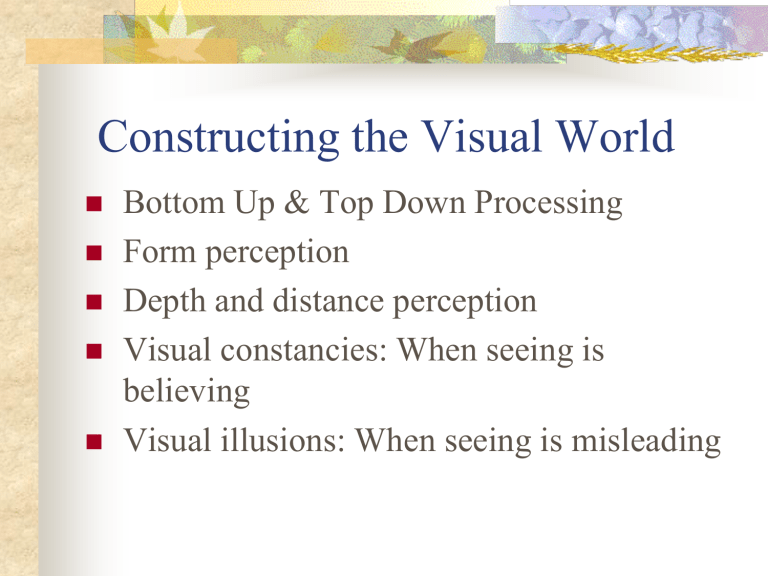
Constructing the Visual World
Bottom Up & Top Down Processing
Form perception
Depth and distance perception
Visual constancies: When seeing is believing
Visual illusions: When seeing is misleading
What do you see??
Group A
You are going to look briefly at a picture and then answer some questions about it.
The picture is a rough sketch of a poster for a costume ball (formal dance) .
Do not dwell on the picture. Look at it only long enough to “take it all in” once.
After this, you will answer YES or NO to a series of questions.
Group B
You are going to look briefly at a picture and then answer some questions about it.
The picture is a rough sketch of a poster for a trained seal act . Do not dwell on the picture. Look at it only long enough to
“take it all in” once. After this, you will answer YES or NO to a series of questions.
Picture
In the picture was there . .
3.
4.
5.
1.
2.
8.
9.
6.
7.
10.
A car?
A man?
A woman?
A child?
An animal ?
A whip?
A sword?
A man’s hat?
A beach ball?
A fish?
Top Down processing
You go beyond the sensory information to try to make meaning out of ambiguity in your world
What you expect (your experiences and your perceptual set) drives this process
Bottom Up processing
Digesting raw sensory information to make sense of something.
Our feelings of pain combine both top down & bottom up processing. (tickling)
How old is the woman on the following slide?
Without speaking, write your answer on a piece of paper.
Perceptual Ambiguity
Your brain tries to make sense of what you are looking at based on the region you are focusing on.
Figure-Ground
To recognize an object (figure) we must first perceive it as distinct from its surroundings.
(ground)
Form Perception – Gestalt
Gestalt principles describe the brain’s organization of sensory building blocks into meaningful units and patterns.
Proximity
Similarity
Closure
Continuation
Proximity
Proximity occurs when elements are placed close together. They tend to be perceived as a group.
The fifteen figures above form a unified whole (the shape of a tree) because of their proximity .
Reading
Similarity
Similarity occurs when objects look similar to one another. People often perceive them as a group or pattern.
Closure
Closure occurs when an object is incomplete or a space is not completely enclosed . If enough of the shape is indicated, people perceive the whole by filling in the missing information.
Although the panda is not complete, enough is present for the eye to complete the shape. When the viewer's perception completes a shape , closure occurs.
Continuation
Continuation occurs when the eye is compelled to move through one object and continue to another object.
Viewer's eye will naturally follow a line or curve. The smooth flowing crossbar of the
"H" leads the eye directly to the maple leaf.
Proximity Video
How does the advertising world use Gestalt
Principles?
Gestalt Principles Gone Awry
Objects located within very little distance of one another. become related as a group, even if they are dissimilar in almost every way--in form, texture, value, or color.
Sign is read from top to bottom because of the how the words are arranged in columns. If read as a column, the words do not make sense, but if read the correct way, the sign tells us something important.
Poorly placed dollar sign…
Gestalt Principles
Proximity
Seeing 3 pair of lines in
A.
Similarity
Seeing columns of orange and red dots in
B.
Continuity
Seeing lines that connect
1 to 2 and 3 to 4 in C.
Closure
Seeing a horse in D.
Depth and Distance Perception
Binocular Cues:
Visual cues to depth or distance that require the use of both eyes.
Convergence: Turning inward of the eyes, which occurs when they focus on a nearby object.
Retinal Disparity: The slight difference in lateral separation between two objects as seen by the left eye and the right eye.
Relax your eyes and try and focus behind the computer screen. (Convergence)
11 little candies should “pop” out.
Retinal Disparity – floating finger sausage
Because our eyes receive different information about an object, their retinal disparity provides a binocular cue of an objects relative distance.
Hold your index fingers about 5 inches in front of your eyes, with their tips a half-inch apart. Now look beyond them and note the weird result.
Move your fingers out farther and the retinal disparity- and the finger sausage- will shrink.
Depth and Distance Perception
Monocular Cues:
Visual cues to depth or distance that can be used by one eye alone.
Horizontal-vertical illusion (perceiving vertical dimensions as longer than horizontal
The Ames Room- vid clip on teacher website
A specially-built room that makes people seem to change size as they move around in it
The room is not a rectangle, as viewers assume it is
A single peephole prevents using binocular depth cues
Perceptual Constancies
The accurate perception of objects as stable or unchanged despite changes in the sensory patterns they produce.
Shape constancy
Location constancy
Size constancy
Brightness constancy
Color constancy
Shape Constancy
Even though these images cast shadows of different shapes, we still see the quarter as round
Color Constancy
Color remains constant even when lighting and wavelengths shift.
It demonstrates that our experience of color comes not only from the object, but everything around it as well.
Visual
Illusions
Illusions are valuable in understanding perception because they are systematic errors.
Illusions provide hints about perceptual strategies.
In the Muller-Lyer illusion (above) we tend to perceive the line on the right as slightly longer than the one on the left.
The Ponzo Illusion
Linear perspective provides context
Side lines seem to converge
Top line seems farther away
But the retinal images of the red lines are equal!
Fooling the Eye
The cats in (a) are the same size
The diagonal lines in (b) are parallel
You can create a “floating fingertip frankfurter” by holding hands as shown, 5-10” in front of face.

